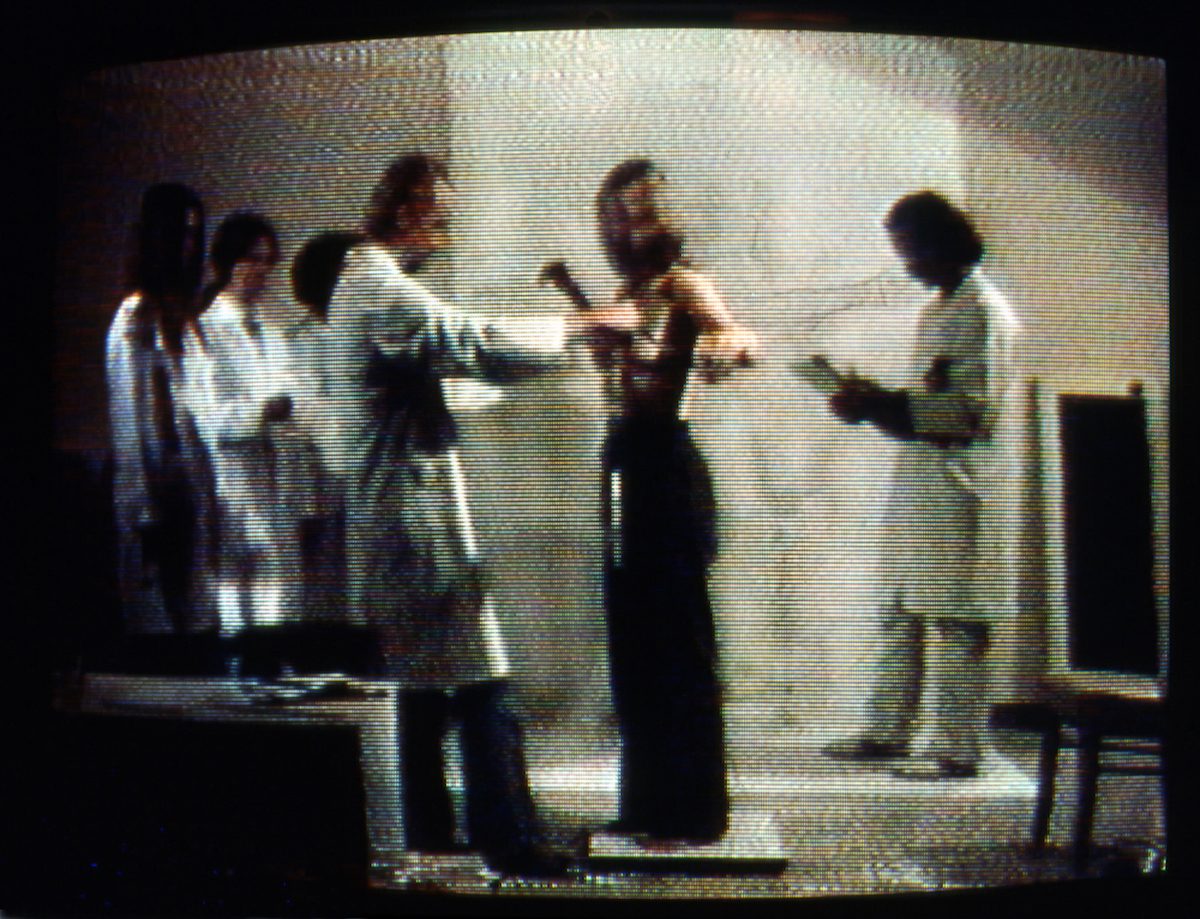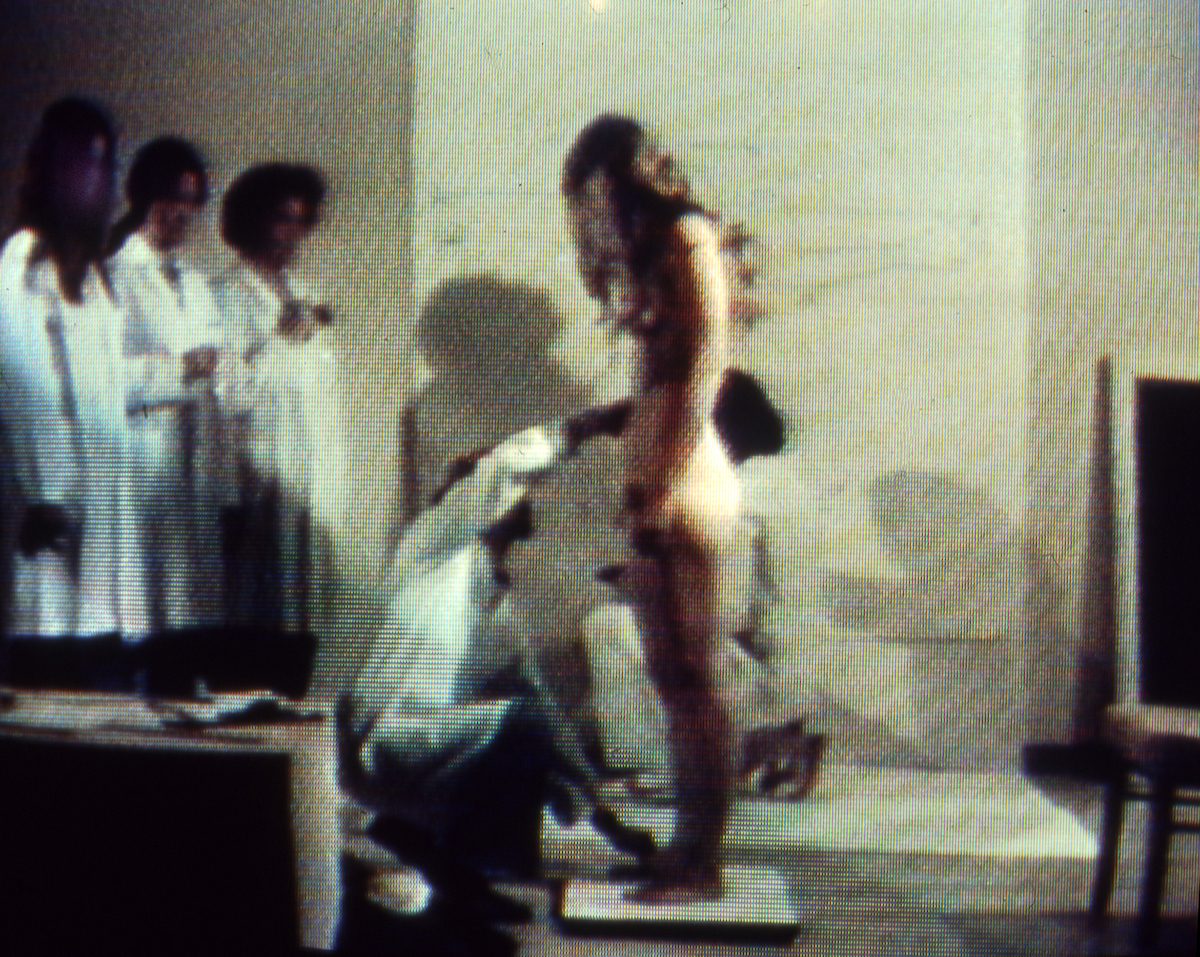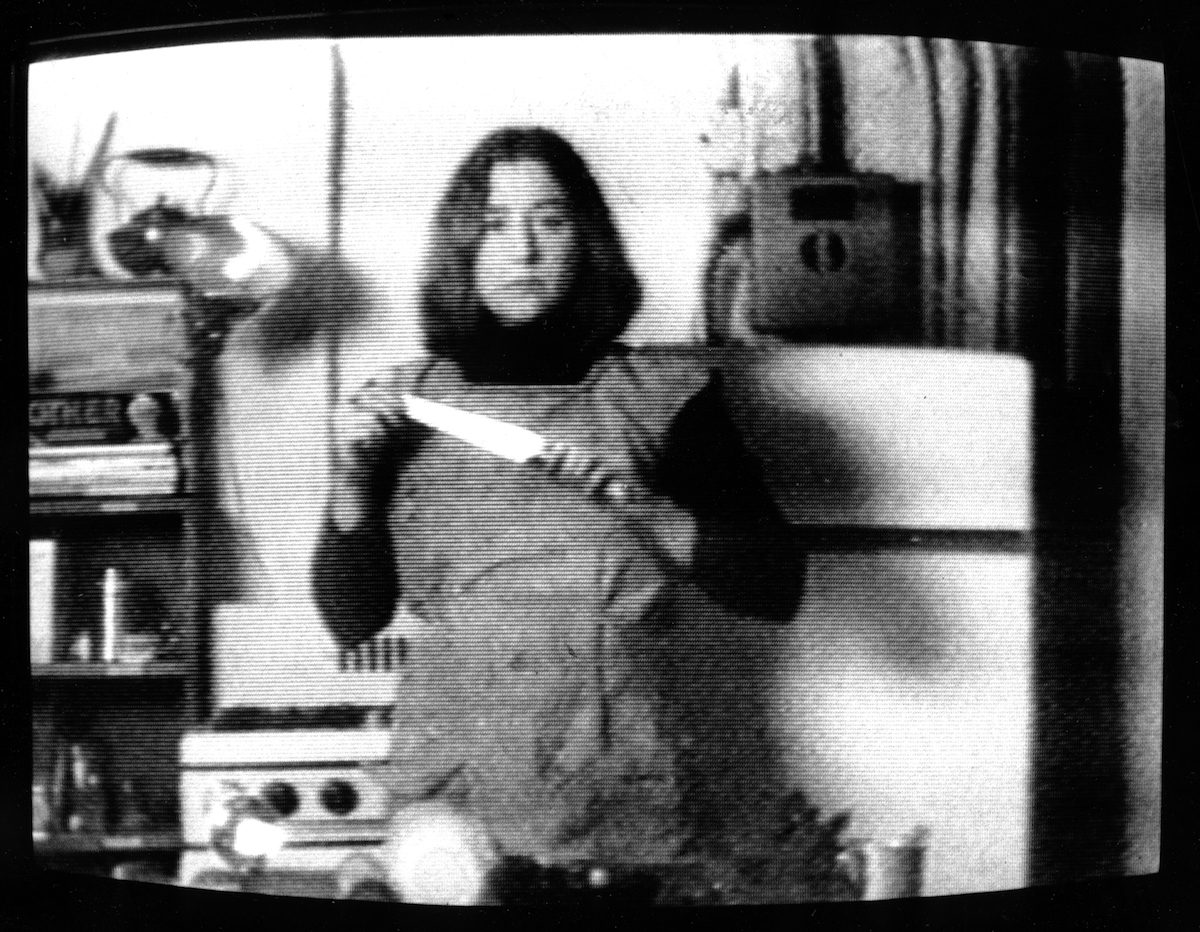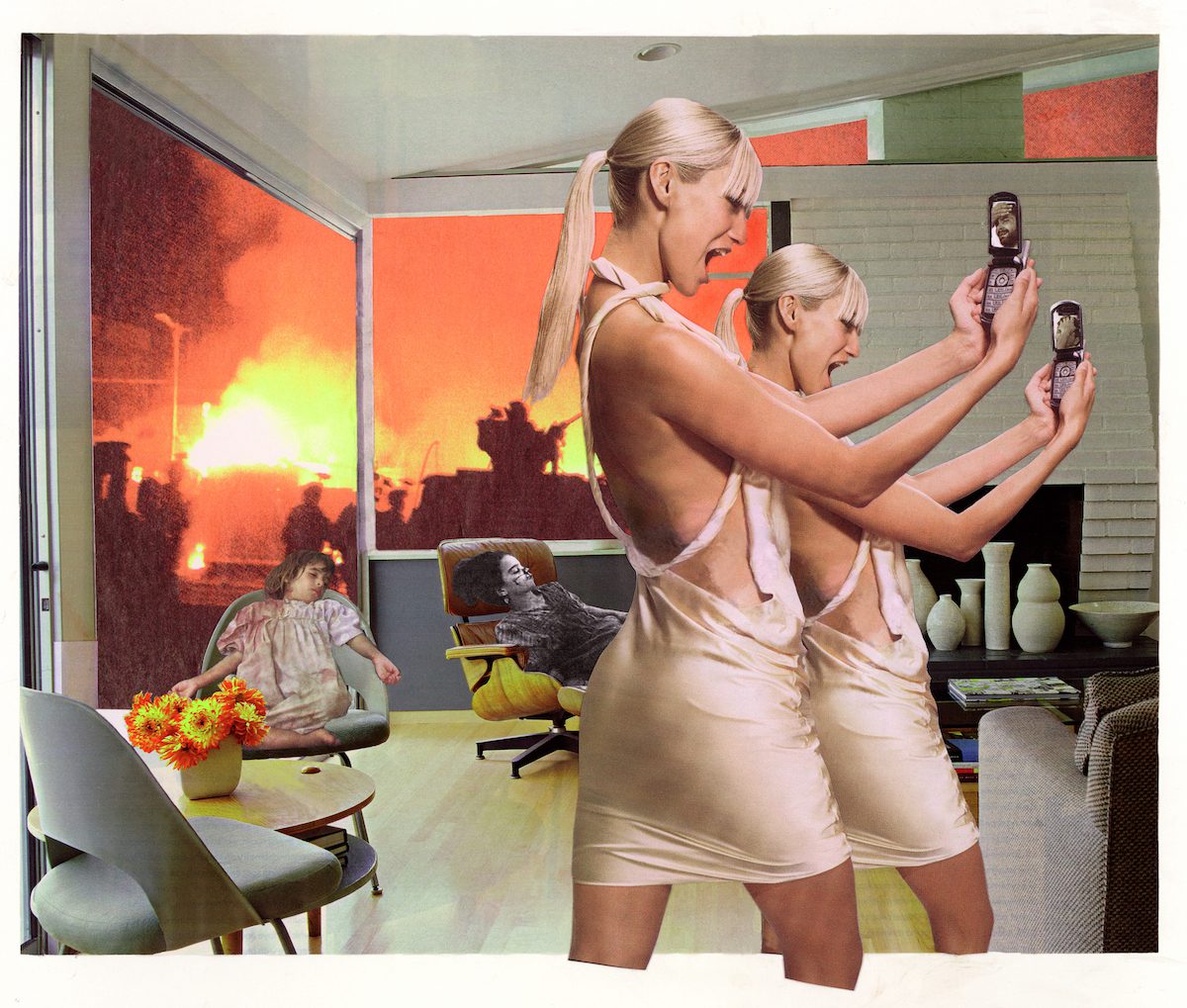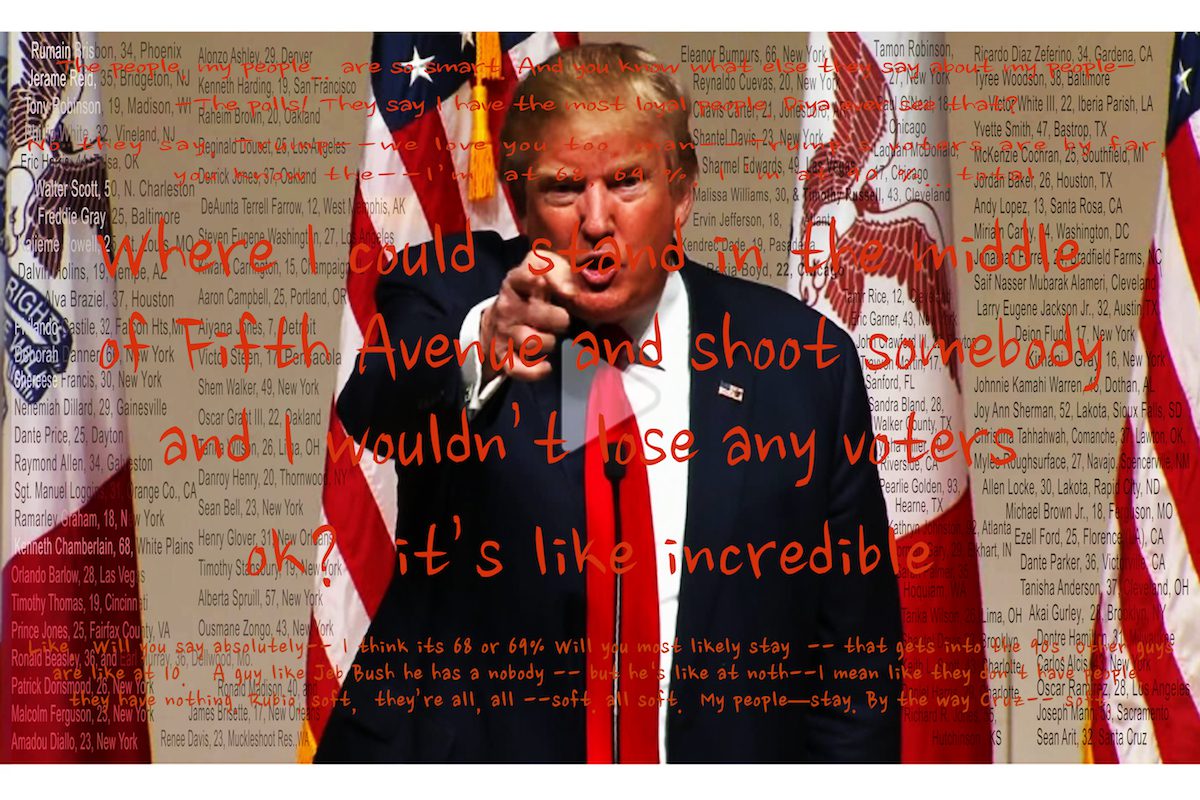For half a century, Martha Rosler has taken on war, racism, oppression, gentrification, and income inequality—rarely in isolation—with uncompromising integrity and deadpan humor. The current survey at New York’s Jewish Museum, which runs through March 3, begins with her feminist and anti-Vietnam photomontages, in which photos of the war from LIFE magazine intrude on images from House Beautiful. It concludes with two recent works: POINT & SHOOT (2016), an image of Donald Trump against a backdrop of names of unarmed people of color killed by police; and a video-in-progress, Pencicle of Praise, edited from footage of the Vice President.
Some videos reveal hidden history: Vital Statistics of a Citizen, Simply Obtained (1977), in which every inch of the artist is measured by a man in a lab coat, was inspired by government directives for the garment industry. Others deliver verbatim readings of texts as absurd as a wok manual in The East Is Red, the West Is Bending (1977) and as dire as a Newsweek op-ed in which a philosopher makes A Simple Case for Torture (1983). She annotates as she goes, arguing. While Rosler is being measured, we hear an account from Scientific American about a boy who didn’t drink enough milk because he had a stay-at-home dad. While we hear the op-ed, we see newspaper articles about women tortured by death squads in Latin America.
It was perhaps the exhaustive research that initially drew me to Rosler’s work. The afternoon I attended the exhibition, while I was trying to watch A Simple Case for Torture, a young woman was loudly expounding to a friend about the importance of newspapers for Rosler’s generation of artists, as if they were wax cylinders. I wanted to say, “Come see my kitchen table on a Sunday morning,” but instead I just asked them to take it outside. But the disregard for sound in video art is beyond the purview of this introduction.
My introduction to Rosler’s work, as it was for many, was her video Semiotics of the Kitchen (1975), in which she brandishes implements violently like a Ms.-era Peg Bracken. But Rosler does not hate to cook, and has been probing the politics of food production and consumption since her MFA show, which has been recreated for the museum. A small selection of her hundreds of cookbooks is on display. And yet somehow, when I visited her in November, I forgot to ask to see her kitchen.
***
The Rumpus: I’m curious about your Brooklyn childhood. Is there a moment you can pinpoint when you became aware of the issues that would later preoccupy your work?
Martha Rosler: I think forever. I went to Yeshiva, and I wrote a poem about integration that was published in the school newspaper. It was Orthodox, so that’s really interesting that they would publish that. I was under twelve, and I remember being very deeply concerned about civil rights. Then I became very concerned about nuclear war and other questions of social justice. And it’s not from my parents, who were liberals but also very worried about any form of political activity and very anti-Communist. Sort of typical New York Jews, except for the ones who actually were Communists. We didn’t know any of them.
Rumpus: When did this find its way into your art?
Rosler: I started making photomontages that addressed the images of women, which of course is political, and then I realized I could make photomontages addressing the question of war. They were made to be photocopied and handed out at demonstrations, and they didn’t have any words on them. They were just meant to create a crisis of cognition in the mind of the viewer, seeing war scenes in and around an idealized American home.
Rumpus: The word “complicit” is very much in vogue at the moment, primarily hurled as an accusation. And there’s a way in which these photomontages implicate the viewer: we’re all consumers, we all enjoy a relatively high standard of living. I’m wondering if that was intentional when you were making them.
Rosler: It wasn’t about guilt, it was about identification: that by bringing people who we associate with another world, the “there,” into the “here,” you would identify with them. We may be in a period of denunciation right now, but before, a more salient political tactic was to ask for inclusion, to ask people to see and join rather than to feel guilty and run away, or whatever people are hoping for now. Denunciation is a stage. What follows that stage? If it’s not organization, what is it?
Rumpus: I feel like a lot of political art just serves to make the viewer smug.
Rosler: I agree. I might not use the word “smug,” so much that it immunizes them against having to do anything. But you know that’s a little bit contrary to what you were saying about guilt, because guilt is supposed to be a driver toward change, although I’m not sure it is. There are also different kinds of political art—if you mean social practice, it’s different from social justice, and so on. But you are right—if we can all celebrate together and go home it’s cathartic rather than a motivator. In other words, it’s church.
Rumpus: People who walk in on Vital Statistics while you’re being measured may think that they’re seeing a work about the pressure on Western women to conform to a certain size and shape. But if they stick around, there’s that identification you’re talking about. More pressing worries than chunky thighs—clitorectomy, purdah, and so on.
Rosler: It isn’t about a comparison of problems. It’s about the way that societies construct their subjects to internalize standards of worthiness, but also the way these standards are formed, and the way that patriarchal societies enforce discipline on women that’s different from a mere internalization. But also a pretty significant element—this is very explicit on the soundtrack—is the way the state promulgates false standards of even things like intelligence and ability and moral character to keep people out of the US. So a whole taxonomy of worthiness is created on supposedly scientific standards in order to justify discrimination.
Rumpus: Your source for this was these documents you found—
Rosler: Pattern Measurement, for clothing manufacturers, to develop patterns for mass production of garments. But it’s very clearly anthropometric. There’s a protocol in the back—here’s where it reveals itself—of what to do if a “Negro” walks in to be measured: you take the measurements, and then you throw them away. Obviously black people were buying clothing. So the idea that clothing manufacturers would not want to factor in African-American measurements is an absurd premise.
Rumpus: Didn’t they want to sell clothes?
Rosler: Well, exactly.
Rumpus: There’s a lot of humor in this video, as there is in a lot of your work—the female lab assistants heralding your passing and failing measurements with a tinkling bell or a duck call. People were laughing.
Rosler: They should be!
Rumpus: It’s rare that you hear that in a museum. There’s the “slyly subversive chuckle” of artspeak, or the ostentatious guffaw of the guy in front of the Philip Guston who’s trying to pick you up. But not a genuine laugh. Why isn’t more art funny?
Rosler: Because that’s how artists differentiate themselves from pop culture, by being serious. And it’s funny because, as you’re pointing out, we’re losing that. But my work ineluctably and beyond my control draws on Jewish vaudeville and shtick. It’s just New York-style dry humor and slapstick.
Rumpus: Anything you can point to and say, “I got this from Nichols and May…”?
Rosler: I’m slightly too old to have been influenced by Nichols and May. Somebody just asked me about Nichols and May and Lenny Bruce. Lenny Bruce I thought was a bit too hard-edged, though all my friends really appreciated him. I most liked Mel Brooks, that kind of idiotic, absurdist humor. I was as much influenced by Ionesco. When I was a kid, television did have a lot of former vaudeville people on. Mostly vaudeville is jokes, and it is a shtetl kind of humor.
Rumpus: How so?
Rosler: Well it’s kind of a smart-aleck repartee, which you can only do among each other because if you tried it on the general population you’d probably be decked.
Rumpus: I don’t really think of Jewish humor as dry.
Rosler: Deadpan. You deliver a line without excessive affect.
Rumpus: And that would describe your performance style.
Rosler: I take great exception to people’s idea now that they should be like MTV, leaping around and having heightened enthusiasm. You’re trying too hard. Let the thing emerge. But this means that when I am presenting my own videos, I can’t leave the room. I have to sit there and suffer through yet another screening so that I can laugh, so that the audience knows it’s okay to laugh.
Rumpus: I go through this at readings. People don’t expect you to be funny, and you’re following three other writers who are maybe “serious” and it takes a couple of pages before people realize it’s okay to laugh.
Rosler: I know. It’s lovely that people feel that culture is serious, except it’s also ridiculous.
Rumpus: In your performance piece for Paper Tiger Television, Martha Rosler Reads Vogue (1982), one of the articles you read is a profile of Cy Twombly at his summer house in Viterbo. Did you choose this issue because of that profile?
Rosler: I think I grabbed whatever was on the newsstand.
Rumpus: Well, the part where you’re reading about Twombly reminded me of your video Domination and the Everyday (1978) in which you’re getting your son ready for bed and the art dealer Irving Blum is on the radio, droning on about Ellsworth Kelly. And you’re reading The Little Engine That Could to your son, which seems metaphorical.
Rosler: But it really happened. If you saw where I lived at that time in southern California you’d have an even better idea. The Little Engine That Could was a perfect thing to read because in the middle of this recording, the train passes. I’m that close to the tracks. I confess that it was a block from the beach, but it still was a hovel on a dirt road.
Rumpus: So it’s equally serendipitous that Cy Twombly happened to be in this particular issue of Vogue. And similarly, you’re a female artist who does not have two homes in Italy, sitting in a Manhattan public access studio reading about another male artist of that generation.
Rosler: I would assume that Vogue had an artist in every issue, or close to it, because they have to prove their worth, because the fashion world wants to own the art world and the art world seeks fashionability. But yeah, it was perfect because he was the ultimate male painter, a guy who does squiggles at the edges of things, and I had been a painter and definitely not a Twombly-type painter.
Rumpus: And then you start spinning this fan fiction about Condé Nast going down on you in a taxi—
Rosler: I don’t have the imagination for that! This woman wrote an autobiography talking about Condé Nast. Muff diver!
Rumpus: In that same Vogue issue, which I was leafing through in the library, Barbara Kafka’s got a cookbook roundup that reminded me of your postcard novel A Budding Gourmet (1974), in which a housewife chronicles cooking foreign dishes with a comic obliviousness. This sounds just like her: “The Modern Art of Chinese Cooking is a magical book. Not only did I feel deliciously fed after reading it, I also felt that I was a consummate Chinese cook and cultural historian.”
Rosler: Did you see The East Is Red, the West Is Bending? That’s what that’s about. I’m reading the booklet that comes with the wok, but there are interventions: how to be a Chinese person, how to be a Japanese person—
Rumpus: And then you shrug and throw the extension cord over your shoulder—again, people were laughing.
Rosler: It’s a comedy!
Rumpus: To get back to your budding gourmet: it’s easy to laugh at the classist and neocolonial underpinnings of her project, but thinking about food culture now—the best minds of my generation have squandered expensive liberal arts educations opening restaurants in neighborhoods we call “emerging” (although not to the people who already live there) that charge two figures for tacos.
Rosler: Well, as you say, we’re kind of squandering our resources, but there is a glut of people with art education and a glut of people who self-define as artists and the fact that they want to be direct purveyors to people with money rather than getting them to buy things to hang on their wall is not that much of a surprise.
Rumpus: When you returned to the kitchens in House Beautiful: Bringing the War Home during the invasions of Afghanistan and Iraq, the perpetrators of violence were now—
Rosler: Anybody!
Rumpus: It could be Lynndie England in your kitchen, with a prisoner on a leash. Which gets us to A Simple Case for Torture. There’s so much that seems prescient, starting with Michael Levin’s opening postulate: a man is threatening to bomb Manhattan. And his last lines: “Some day soon a terrorist will threaten tens of thousands of lives, and torture will be the only way to save them. We had better start thinking about this.” And we did. Were you filming yourself looking at the World Trade Center because that seemed like the obvious target?
Rosler: Well, it stuck up way above the other buildings. There’s also a shot where the words “Liberation of the body from social necessity” are over the Twin Towers. I hated those buildings so much, and thought of them as so inhuman in relationship to the cityscape, but it never occurred to me that somebody would actually blow them up. But his scenario was about blowing up Manhattan, and what would be more perfect than to blow up Wall Street, which is right there?
Rumpus: Have you ever had any contact with Michael Levin, or followed his weird career?
Rosler: His weird career is he became an overt racist! Michael Levin is a bad actor.
Rumpus: Per the Southern Poverty Law Center: “Michael Levin…is an unabashed white supremacist who argues that black people are innately less intelligent, less moral, and more criminal than their white peers.” And he teaches at City College, in Harlem.
Rosler: Well, I would say, “Beware of personalization.”
Rumpus: What does that mean?
Rosler: It means Michael Levin is not our enemy. He is an enemy among enemies. You could kill all the racists and we’d still have racism unless we get better about making sure we don’t have the racist culture. Somebody asked me, “Were the names in the Trump piece meant to say that these extrajudicial killings of people of color were a result of Trump’s remark, or his general remarks?” and of course the killings predate Trump. They are an expression of the ability to dispose of and misdirect the lives of people who are considered inferiors.
Rumpus: Let’s talk about the Trump piece. You made this pretty soon after the election.
Rosler: Yeah, I was asked to make a piece for Artforum online, and I thought. “Oh, I can’t think about this—oh, wait, I know what I can do.” So I did it.
Rumpus: And the Pence piece—was there any specific impetus for this?
Rosler: Yeah, looking at Pence! I was thinking, what the fuck? He’s worse than Trump. If Trump is dominated by id, Pence is dominated by superego. He’s full of sermonizing and gratitude—and let me speak out against gratitude as a trope. It’s disgusting. It’s super-Protestant, which, as a Jew, I have trouble identifying with. The whole idea that somehow all the mean, hideous, discriminatory, and evil things you do and believe in are based on gratitude just makes me nuts.
Rumpus: I don’t follow you.
Rosler: Well, you’re thanking God for all your great virtues and not falling into the trap of being a lowly and miserable person, because God didn’t make you that way. Pencicle of Praise is about him obsequiously expressing hymns of praise to Donald Trump and all the wonderful things he’s done, and then he orchestrates this cabinet meeting where all the poor victims (I say that sarcastically) have to express their gratitude to the president, who sits there with his arms folded and his eyes glazed over, thinking, “What an obsequious little ass you are, Mike!”
Rumpus: In the middle of the room with the Trump and Pence pieces is Reading Hannah Arendt, a work you did in 2006 for the Arendt centennial. Quotations from The Origins of Totalitarianism are printed on transparent panels, and they’ve been positioned so that you can regard the Trump work through a quotation about bullies, or the Pence work through a quotation about sycophants. The day I was there, people were lingering and there was a sense of catharsis. Is catharsis enough in this particular situation, because we’ve had such a rough two years?
Rosler: I don’t consider it cathartic. The accusation that’s always leveled at people that make political work is that you’re preaching to the choir, to which I would say, you marshal the troops first. They’re your first and best audience. You motivate your people, help remind them what they’re against and what they’re for, and hope they take it from there. Because it ain’t art that’s going to make a change, it’s people that are going to make a change.
***
Image credits in order of appearance:
Photograph of Martha Rosler © Josep Fonti / PIN–UP.
Martha Rosler, Red Stripe Kitchen, from the series House Beautiful: Bringing the War Home, c. 1967-72, photomontage. Artwork © Martha Rosler; image courtesy of the artist and Mitchell-Innes & Nash, New York.
Martha Rosler, still from Vital Statistics of a Citizen, Simply Obtained, 1977, color video, 40 min. Artwork © Martha Rosler.
Martha Rosler, still from Semiotics of the Kitchen, 1975, black-and-white video, 6 min., 30 sec. Artwork © Martha Rosler.
Martha Rosler, Photo-Op, from the series House Beautiful: Bringing the War Home, New Series, 2004, photomontage. Artwork © Martha Rosler; image courtesy of the artist and Mitchell-Innes & Nash, New York.
Martha Rosler, Point and Shoot, 2016. Digital Print. Courtesy of the artist and Mitchell-Innes & Nash, New York. Artwork © Martha Rosler.


